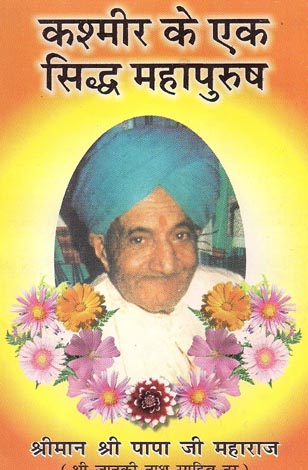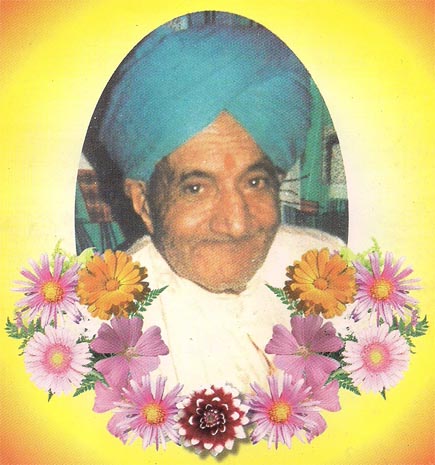|
THE LITTLE KNOWN SAINT OF KASHMIR
- N.N. Dhar
It is soon going to be three years since the
demise of Shriman Papaji Mahraj Pandit Jankinath
Dhar. Like in many years in the past, before and
after his death , his devotees celebrate his
birthday on April 13 (vaisakh Krishna paksh
saptami) with a yagyna.

Shriman Shri Papaji Mahraj, as he was
reverentially and affectionately called by his
devotees, breathed his last on July 30, 1990 at
8.30 pm at his last earthly abode at 22,Dudganga
Colony, Chanapura, Srinagaar Kashmir. He was about
90 years old.
During the last days of Shriman Papaji’s life,
militancy in Kashmir valley had acquired a new
peak. Terrorist activities, which resulted in
curfews, hartals and indiscriminate and wanton
killings, posed a great danger to people living in
the state. Because of this, on his death even a
competent priest was not available to perform the
last rites of this great scholar and saint.
The sacred earthly remains of dear Papaji were
consigned to flames in a very tense atmosphere in
the presence of a small number of his devotees and
family members at the crematorium at Rameshwar
Temple at Natipora, Srinagar on July 31, 1990. No
customary rituals could be performed. I remember
that a few years earlier , during an illness,
Papaji had somewhat unconsciously mumbled a few
words to the effect that there would be no "Daha
Sanskar" as such for him on his death.
Papaji was a rishi of a unique order. Even his
closest associates could not fathom the depths of
his greatness. For most of his life Papaji Mahraj
worked in the office of the Accountant General,
Jammu and Kashmir Govt. He continued his spiritual
quest both while working in the Government and
looking after his family. This is remarkable.
For a few years Papaji worked as an accountant in
the late Maharaja Hari Singh’s Rajput Boarding
School started in 1930 or so in Jammu. One captain
Kala Singh was its Principal and Papaji, while
maintaining the accounts, also assisted and
advised him in running the institution. Papaji had
been allotted a room (which he would call "the
cubicle") at the back of a big building which then
housed the state public library. The building has
since been replaced by the present secretariat
complex.
In his "cubicle" Papaji underwent tapasya of a
very high order. Here he studied the various Hindu
schools of Philosophy. He mastered the Sankhya and
the Vedanta. Quite late in life, once it just
happened that he had to admit that he was a Shat
Shastri. Considering his innate unassuming
nature,it was an amazing revelation.
During this period, he practiced Patanjali Yoga,
performed pranayama and underwent many other yogic
exercises of rare kind. These necessitated diet
restrictions and strict physical discipline. He
survived only on milk and fruit and avoided the
intake of salt completely. He drank deeply from
the immortal fountains of Upanishads. He studied
thoroughly the Brahmasutras and other sutras .He
imbibed the true meaning and spirit of the Bhagwat
Gita through all available Sanskrit commentaries.
Intensive study, physical and mental discipline
and meditation as prescribed by shastras
culminated in his Aprokhsha Sakhshatkar, coming
face to face with the ultimate reality. With
regard to his studies, Papaj’s main thrust in life
was on Vedanta which may be called his first love
to which he stuck to the very last. At the same
time the true aspirant that he was, he could not
possibly ignore the great Shaivic Philosophy which
has its origin in the land of his birth . Enough
was not enough for Papaji! The great saints,
Somananda, Utpaldeva, Abhinavgupta and other
propounders of Kashmir Shaivism were as familiar
and dear to him as the Vedantic acharyas, Gaudpada,
Shankara, Madhusudana, Vidyaranya and others.
Papaji grasped the subtle difference between the
two philosophies. According to him,only a true
student of the two could exactly sift the essence
of the one from that of the other.
Before taking up the learning of Sanskrit, Papaji
had managed to have a good command over Persian
and Urdu languages. He had read the classical
works of a horde of great Persian sufi writers
and poets like Hafiz, Roomi, Saidi and others,
including the renowned sufi poet, Habibullah
Nawsheri of Kashmir and also the poetical
compositions, "leelas" of the great Kashmiri Pandit saints, like Parmanand, Rajkak, Mirzakak,
Lalishwari, Prakashram and many others.
He learnt Sanskrit and Hindi later, at the age of
22 – 23 when he started with the Devnagri
alphabet in a Sanskrit Pathshala attached to Som
Nath temple, Habbakadal Srinagar. Before launching
on the study of the various philosophical and
religious works in Sanskrit, he had to study
thoroughly Sanskrit prose, poetry and drama to
gain necessary proficiency and fluency in the
language. He succeeded in this task with
remarkable speed, not ordinarily possible. He
became a great admire of Kalidasa, especially his
Shakuntala.
Papaji was also well conversant with the Ayurvedic
and Unani schools of medicine. He possessed sound
knowledge of varied subjects like dietetics,
physical culture and sex. He was a lover of music.
He had a special liking for Persian and Kashmiri
Sufiana music. He patronized a few existing
kashmiri sufiana musicians, now an extinct lot,
and would himself play on the sitar.
By the time the end came, Papaji’s devotees were
spread all over. Except for a visit to Delhi for
treatment a couple of years before his death ,and
very brief visits to Calcutta, Bombay, Pune, Agra
and Brindaban, in earlier years and the service
period in Jammu, he remained confined to Kashmir,
mostly Srinagar. After retirement from service, he
would meet his devotees either at his residence or
at his ashram Utkrishta Parijat Ashram,at Gouri
Shankar Temple,Upper Sathoo, Srinagar. When he
became very week, he spent most of the time in
meditation,blessing all those who came to him.
In pursuance of a proposal made in October 1990,a
trust, Shri Papaji Memorial Trust, has been
registered in Delhi. Initially, a memorial is
contemplated to be built, a temple with Papaji’s
statue in marble, having an adjoining assembly
hall of a suitable size. The primary aim of the
proposed memorial is to perpetuate Papaji’s sacred
memory. His devotees can meet there to offer
prayers, jointly and individually, and seek his
blessings as was done during his lifetime. Other
charitable, social, cultural and religious
activities, like celebrating Papaji’s birthday and
his Mahasamadhi day, can also be carried on there.
Papaji spent the major part of his life in
Srinagar and a brief span at Jammu. For reasons
obvious enough, the memorial cannot be raised at
Srinagar, the place of Papaj’s birth. Under the
prevailing constraints, Jammu seems to be the most
appropriate place to have the memorial. In fact,
it was at Jammu where, authentically speaking,
Papaji attained God realization.
A managing committee composed of some of his
devotees is now working out a plan for the
memorial.
Courtesy: Koshur
Samachar
|
















No one has commented yet. Be the first!